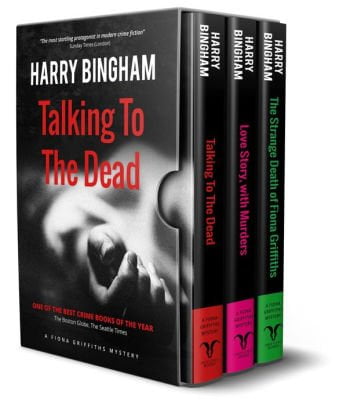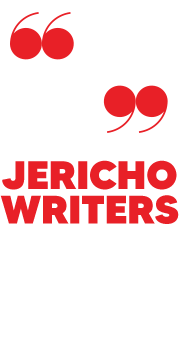We’re storytellers, so I’ll start out with a story. (It’s Harry Bingham writing, by the way.) The story is true, and has been life-changing for me. Follow some of the advice in this post, and your life might change, too – in a very, very good way.
How Self-publishing E-books Makes Me An Easy Six Figures
A few years back, the first novel in my Fiona Griffiths crime series was bought by Kate Miciak of Delacorte/Bantam Dell in New York. If those names don’t mean anything to you, suffice to say that Kate also edits the work of Lee Child. Back then, she also edited the work of Karin Slaughter. She edits, or has edited, the work of countless other megastar authors. Delacorte is an imprint of Penguin Random House, and a leading crime imprint in the US.
My literary agents in the US and UK were (and are) both outstanding, so it looked to me like I had pretty much a full house, aces over kings. The perfect editor, at the perfect imprint, at the perfect publisher, and with superb agents by way of support. That’s dream-come-true territory.
Only, of course, if the book was lousy, no amount of good publishing would save it, so there was that to consider. There was a possible pitfall right there.
Except – the book did okay. It got a starred review in Publishers Weekly. A starred review in Kirkus. A full four stars in the USA Today. It got rave reviews in the Boston Globe, the Seattle Times, and a host of others places too.
Second book in the series, the same thing. Brilliant reviews. Great publishing team. The best names in the business.
And the books flopped.
Curled up and died.
They did so badly, that the second book never even went into paperback.
How come?
Response from readers had been good. Things seemingly lay more in the difficulty that my publishers had in finding the right look – the hardback of that first book had a nice but weird cover on it. Retailers were unconvinced, and didn’t stock it. Readers, the same. When they saw the book in store, they didn’t really know what kind of book it was.
The failure of that cast a pall over a radically rejacketed paperback. Since that also didn’t sell, the second book was pretty much dead in the water, despite yet another desperate attempt at rejacketing and rebranding with the hardback of the second book.
And that was that. My US career pretty much over. Nice reviews, no sales. Too bad – but I believed in those books. And if what I’ve described was correct, that seemed to me an extremely solvable problem.
So I wasn’t quitting the North American market.
My Self-Publishing Experiment
I chose to self-publish book #3 in that series (more about how to do that in a minute). That experiment went well, so I bought back the rights to books #1 and #2 from the (very generous) people at Penguin Random House. That repurchase cost me $10,000, but it was probably the best investment I’ve ever made.
In June 2017, I published #6 in that series. I’ve earned about $100,000 from my Fiona Griffiths books over the last twelve months. I do almost no marketing. I release just one book a year. I have an incredible relationship with my US readers – the best I’ve had in twenty years of being a professional author, and readers like my books. I hope you’ll agree that’s a great outcome.
How do you achieve it? What’s the secret?
Well, two things.
Number one: my books are good. If your books are poor, or even mediocre, they won’t get that level of success and, frankly, don’t deserve it.
And number two: I self-published an e-book. (Or, rather, a series of e-books.)
Yes, I also sell in print, but ebooks account for 95% of my sales, or more. And the print sales I do get arise, almost entirely, as a result of my ebooks’ visibility.

Why Ebooks Haven’t Peaked – And Are Here To Stay
Is this all a bubble, though? A flash in the pan?
Well, you might well think so, given the number of daft stories like this one, which claim the ebook revolution is on the wane.
And the short answer is that, yes, the number of ebooks sold by traditional publishers have flattened off and even dipped, but that’s largely the result of an acute decline in the market share of traditional publishers.
The Association of American Publishers reports double figure declines in ebooks. The British Publishers Association notes that sales of trade fiction (i.e. novels for adults and kids) have declined by a quarter. In five years.
Ouch!
That’s a horrendous loss of revenue, but it’s not that people have stopped reading books. It’s that they’re not reading traditionally published work in anything like the same quantity.
What AuthorEarnings.com tells you is that, between 2014 and 2016, Amazon’s own publishing imprints doubled their market share. Indie authors have relentlessly accumulated share.
And traditional publishers as a group, and the large publishers most of all, have lost share seriously.
In short, the ebook market is thriving, and the market for books of any format sold online is now utterly, utterly dominant. AuthorEarnings reckon that sales of adult fiction are now more than 75% online, and that’s just unbelievably excellent news for writers like you.
Why?
Because you can’t compete in bricks and mortar retail. Except in exceptional circumstances, or in minuscule volumes, your books just won’t get sold through those channels.
You have fully three quarters of the entire market for books to aim at, and:
- Not only can you compete here – no one is blocking your way
- But also it’s free to compete here – there’s no entry charge
- The dominant player wants you to compete here – it positively welcomes self-pub authors
And best of all:
- You actually have a competitive advantage over big traditional firms, because readers positively want a direct connection with the author. No one in the world positively wants a direct connection with some giant multinational. You have a marketing edge they cannot match.
So it’s perfectly possible to make good money with e-books. As Amazon continues to flourish, the indie tide is rising all the time. The simple fact is:
More and more indies are making more and more money than ever before. Next year will be better than last year.
Good to know, right? But money doesn’t just drop into your lap. You gotta to go make it. So – after a pretty picture of that rising tide – let’s go figure out our next steps.

Step 1: Set Up An Account With KDP
KDP stands for Kindle Direct Publishing and you will grow to love those intials very much indeed.
You just go here – https://kdp.amazon.com/ – and sign in with your regular Amazon account. If you have everything else ready, you are about ten minutes away from publishing your first ebook.
Step 2: Prepare Your Ebook (In Word)
It’s absolutely fine to prepare your book as a regular Word document. Just be aware that you need to think about an ebook in three sections:
- The front matter: this is the “Look Inside” section and you need to prepare this part thinking about readers who are curious about your book, interested in buying it, but who haven’t yet made the purchasing decision. This is the place for any lovely reviews you may have, any good selling text – and of course plenty of the actual book itself. What you don’t want is any tedious copyright notices and that kind of thing. Yes, sure, you have to get those in somewhere, but you can bundle them right out of the way, at the end of the book.
- The book itself: Obviously you want to make this as strong as possible. Your only thought here should be to deliver the very best reading experience possible.
- The end matter: This is where you want to solicit reviews for the book and, crucially, where you want to collect your readers’ email addresses. I’ll tell you how to do that in a moment, but it’s probably the single most important element in the whole selling chain, so don’t neglect it.
Make sure as well that you have done the basic formatting bits and pieces right. So, for example, you need to:
- Use the tab key or the paragraph format menu to indent paragraphs. (Do not just hit the spacebar five times: that’s a real formatting no-no.)
- Ensure total consistency in your chapter numbering and formatting. So if you use simple digits to mark out each new chapter, make sure those things are formatted the same way every time.
- Ensure consistency in other headings, such as Author’s Note, About this Series, etc
- And of course, the entire book should be in a single document – don’t even think about trying to format something chapter by chapter
If you want KDP’s own formatting guide, you can get it here.

Step 3: Create Your Cover
Top-end cover design is hard. It can be fairly expensive. And, even if you splash the cash, results can be curiously disappointing. Nor is that even surprising, really, given that everyone knows that covers really matter, and everyone is trying to out-compete everyone else.
Just don’t get too worried. It’s not hard – it’s actually easy – to get a good, professional cover on your book. And it doesn’t have to be expensive, either.
For a really detailed overview on how to commission a cover, check out our advice, but mostly I’d suggest that you:
- Search “pre-made book cover.” What you’ll find here is huge libraries of covers that have been put together by pro designers and then discarded. If that sounds crazy, then bear in mind that a large publisher or picky author may well commission multiple designs, in order to pick one. Rather than bin the unwanted designs, designers simply remove the specifics of author name and title and make the design available to anyone with $50-100 to spare. Sure, the cover may not be super-specific to your book, but that really, really doesn’t matter. Readers buy on mood and genre-indication. The specifics just aren’t relevant.
- Fly solo, using Canva. Canva announces itself as ‘amazingly simple graphic design software’ and it really is easy. It offers a variety of book cover templates. You just pick a photo. Add your text. And off you go. Depending on whether you use a free image or not (I’d suggest probably not), that route will cost you between nothing at all and a few bucks.
Step 4: Format Your Ebook
These days, you have multiple options for formatting an e-book. You can:
- Pay someone. These people, for example – but look at various quotes, as you shouldn’t really be paying more than $100 for this service.
- Do it yourself via Scrivener, if you like Scrivener.
- Do it yourself via Vellum, if you like Apple.
- Do it yourself via Draft2Digital. (The service I mostly use – it’s free.)
- Do it yourself via KDP’s own conversion platform – though this will leave you with a mobi file only and all other e-tailers use epub files. (These are basically the same, but also irritatingly different.)
The DIY version of things is fast and simple.
Once you’ve got the hang of a particular system, it’s a ten minute chore, if that. Remember that the cover is part of the e-book, so you can’t progress to the formatting step until you’ve got your cover sorted.
And of course once you’ve ticked off this step – congratulations! You’ve created your product. Now your only job is to get it on the shelves and starting to sell.

Step 5: Set Your Ebook Details
So the new model is to ignore the keyword bundling, and instead use subtitles that present the book in the most attractive possible light, e.g., “The Seventh Corpse: A tense thriller that you won’t be able to put down”.
I think that’s a better strategy, and it’s the one I recommend. Do note that Amazon requires you to have the text of the subtitle present somewhere on the cover. (You can read more about their requirements here.) But Amazon doesn’t effectively enforce that rule and the truth is that, at the moment, you can ignore it if you want to. So one perfectly practical strategy woul be: experiment with different subtitles, see what works best, then change the cover when you’re ready. But also: don’t spend too long on all this. It’s not a game-changer.
Series
Is your book part of a series? If so, say so. Anyone searching for my books, for example, might use my name to look for them, or they might look for the name of my detective protagonist, Fiona Griffiths. To make sure that anyone searching for “Fiona Griffiths” finds my books, I call my series “Fiona Griffiths”, and Amazon will add “Book X” to each book in the series.
So, for example, my sixth book in the series is entitled (with title, subtitle, and series data) as follows: “The Deepest Grave: An ancient battle, a dead researcher, and a very modern crime (Fiona Grifiths Book 6)”. That’s not a bad template to follow.
Edition
You probably won’t need to use this. You can just ignore it.
Author
That’s you. Check for typos! Don’t misspell your name.
Contributors
Do you have co-authors? Illustrators? Other collaborators? If so, this is the spot to include them.
Description
The book description matters. It’s how you pitch to the reader. How you convert that opening interest into the hook of purchase-intent. I like descriptions that follow a little story arc all of their own. So:
- An opening sentence or two, that acts as a hook, or teaser. The purpose of this sentence is to make the reader curious and choose to read on.
- The blurb proper. Usually this will describe the set up only, and will include those elements most likely to intrigue the reader.
- A cliff-hanger type ending. The sort of thing that runs, “But that’s when he started to realise how serious the danger really was – and when he wondered if he’s escape with his life.”
You can definitely choose your own strategy, but that basic Teaser – Content – Cliffhanger template is hard to beat.
Note that if you want to make use of bold, italics, and that kind of thing, then you can. If you know basic html, then feel free to use it. If you don’t, then use a simple formatting tool like this one, to generate beautiful looking text. Don’t overuse those tools though – too much bold just looks childish. Keep it nice!
Rights
You need to declare that you own the copyright and hold the necessary publishing rights. If you are the author of the work, then you’re fine.
Keywords
These are the keywords that help Amazon determine what kind of book yours is and will guide what searches it appears under. Amazon’s own guidelines – here – are quite helpful, and you should use them. Do remember that it might seem clever to shove a keyword like “thriller” into your keyword choices – because lots of people like thrillers, right? – but your book is unlikely to feature on highly competitive searches, unless you have reason to be very confident of hitting a good salesrank early. Again, it’s worth doing a reasonable bit of research into possible keyword selections, but don’t go crazy. 2-3 hours work on this is easily enough, or more than enough. Keyword choices won’t make the difference to your sales.
Categories
Just choose the library-style classification for your book where your readers are most likely to congregate. For me, for example, I choose these categories:
Fiction > Mystery & Detective > International Mystery & Crime
Fiction > Mystery & Detective > Police Procedural
The ‘International Mystery & Crime’ category is relatively niche, but works very well for me, because I want US readers with an interest in non-US set crime. And ‘police procedural’ precisely describes what I write, so I’m going to find my natural readers in that category.
Age range
Self-explanatory. If you’re not writing for kids, this isn’t relevant.
Pre-order
Unless you are an experienced author with a strong sales plan, I’d recommend against using a pre-order. And even if you are experienced, they may not work for you. I don’t pre-orders myself any more and my sales have benefitted.
And, to be clear, if you don’t set a pre-order date, then your book will publish within about 24 hours of you hitting the publish button at the end of this form. You are that close to getting out there!
Yowch! This is a lot to take in, right?
Yep. One big reason why a lot of self-publishers mess up is that they’re so keen to get published that they don’t invest enough time in learning how to do it right.
(And yes, I’m guilty of that myself. I threw away plenty of easy money as a result.)
So we created a really comprehensive, easy to follow, step-by-step video course that teaches the whole self-publishing game – and it’s designed for people just like you.
And yes, yes, I know. As soon as someone says “video course” to me, I think here comes the hard sell for a product which might really be great, but which is going to have some eye-watering price.
And yes, the course does have an eye-watering price (details here), but you can get it free.
That’s right. You can get an entire, super-premium video course FREE, just by taking out membership of Jericho Writers. We’re a club, founded by writers for writers, and our aim is just to deliver a spectacularly huge amount of value within that membership. So it’s not just that one course. We’ve also got an incredible how to write course. Loads of stuff on trad publishing. Filmed masterclasses. Live online webinars with agents, writing tutors and more.
If you’re even one tiny bit interested (and, if you’re reading this blog post, then you darn well should be), then hop over here to learn a whole heap more. We look forward to welcoming you soon.

Step 6: Set Your Ebook Content
We’ve already dealt with the two biggest ingredients of your content: your book itself and your cover. With those two items, just upload the relevant files and wait for Amazon to digest them. I do recommend that you use the eBook previewer tool: it’s just a comforting way to make sure that everything looks as it should do before you hit publish.
In this section, however, there are three other things you need to think about.
DRM choice
You can choose whether or not to protect your book from potential piracy with ‘Digital Rights Management’. And while protecting your book sounds like a no brainer – of course you want to protect it! It’s your baby! – the simple fact is that DRM doesn’t work. Easily available software can strip the DRM out of your book in a couple of minutes, and once some idiot has done that, the pirated version of your book can spread everywhere anyway.
Meantime, DRM can be a real pain for perfectly legitimate readers who may want to lend your book, read on a new device, or whatever. So my choice – and this would be the advice of a majority of experienced indie authors – is not to enable DRM protection. Realistically, there just isn’t much you can do about piracy. Treat any manifestations of piracy as a compliment to your book and your writing, and focus your efforts on all the millions of legitimate readers who want to buy, not steal, your book.
ISBN
To get your book into a bricks and mortar bookstore, you would need an ISBN – effectively an international identifier for your book. But e-books don’t need ISBNs. And even if you’re publishing in print with Amazon as well, you can let Amazon just allocate a free ISBN to you when you publish. So basically, just ignore the ISBN box. It doesn’t matter to you.
Publisher
Huh? You’re the publisher, right? So why is KDP asking you for this information?
Well, no reason, really. Lots of self-publishers just leave this box blank, and there’s no reason not to do that. But personally, I just like the idea of having a publisher’s name on my books, so I call my publishing imprint ‘Sheep Street Books’ and give that phrase to Amazon when it asks me for my publisher.
Note, there’s absolutely no requirement for any legal substance here. There isn’t a legal entity called Sheep Street Books. My accountant doesn’t have to handle anything different. It’s literally just a name. Nothing more. But it’s nice, no?
Step 7: Choose If You’re Going To Go Exclusive To Amazon
At this stage, you need to determine if you’re going to make your work exclusive to Amazon or not.
That sounds like a bad idea – why wouldn’t you want your book to be sold in every store possible? – but there’s a catch. The thing is, Amazon doesn’t just control the world’s largest bookstore (Amazon.com), it controls the second biggest one too – Kindle Unlimited, which makes e-books available for free to participating members. The word ‘free’ in this context might cause you some alarm but, be not afeard, Amazon pays about $0.0045 for every page of your book that a KU subscriber reads. Your KU income, therefore, comes in the form of payments for pages read, rather than a traditional type of sale.
And KU is huge.
KU is disproportionately important to indie authors and, indeed, indie authors in 2017 made a total of about $180 million from Kindle Unlimited, compared with just $50 million a year from Apple and all other non-Amazon sources.
To me personally, that logic is overwhelming. I offer the first book in my series wide (i.e. with every store) in order to capture as many readers as possible. After that, though, all my books are Amazon exclusive. I make about a third of my income from KU reads and I know some very successful authors who make a full 50% of their income from KU.
If you are just starting out, then I urge you to follow that exact template. When and if you start to generate decent sales for your series, you should reconsider the matter. Some pro indies urge the wide route; others advocate the narrow one. For these experienced authors, there’s a real choice. But starting out? Go narrow. Make it work. Then think again.
Step 8: Set Ebook Pricing
Finally, you need to determine royalties and pricing.
Amazon likes people to sell e-books in the $2.99 to $9.99 range. It wants to avoid excessively high pricing (because that would damage the extent of the e-book market), but it doesn’t like super-low pricing all that much either (because it doesn’t make enough money.)
The result is that is offers an (amazing, brilliant, wonderful) royalty of 70% to indies publishing their books within that range and a (still good) royalty of 35% outside that band.
In terms of where you should sell your books, you need to think about (A) where you want to end up, and (B) the best way to start out.
A typical end-point for you will be something like mine:
Book #1 – $0.99 (make it attractive for readers to get into the series)
Book #2 – $4.99 (make some money)
Book #3 – $4.99 (make some money)
Book #4 – $4.99 (make some money)
etc
But you can only sell books in volume at $4.99 or more if you already have a bunch of committed readers. If you’re not yet at that stage, then remember:
FREE IS A MARKETING STRATEGY
What’s more, and by the same fine logic:
CHEAP IS A MARKETING STRATEGY
Sure, you don’t actually make any money from free, and you don’t make much from cheap . . . but your job now is to tempt readers into your series (and your book’s job is then to blow them away.)
For newer authors, then, I think you want to fool around at the $0.00, $0.99 and $2.99 price points to find readers and build your base. Remember, you can change your decisions at any time, so just try out one option, see what happens, then change it if you need.
Step 9: Hit That Button, ‘Publish My Kindle Ebook’
You’ll get a message telling you that the book may take up to 72 hours to be published, but it’s generally a lot less than that.
You’re on your way, my friend. You’re a published author now.
But don’t walk alone.
We created our Jericho Writers club to be here for you on your journey. We’ve helped all types of writer get published, including some of the biggest selling indie authors of recent years. I’m not going to start yelling about how much we make available for free in our club (clue: it’s masses). Instead, I’m just going to tell you to hop over here and take a look.
Honestly? I think it’ll be the best investment you ever make.
Step 10: Market Like Crazy And Build Your List
I told you earlier that that the back matter for your book needed to include an inducement for readers to leave you their email address. The way you do that is by deploying the power of free. You create a reader magnet – a nicely written, properly formatted short story with a decent cover – and say, “Get my wonderful story, for free.”
Readers, blown away by the power of your storytelling, sign up for this new free story. You send it to them by email. You now have their email address . . . and their permission for you to market to them direct.
That, in essence, is the strategy that lies at the heart of every self-publishers success. Your core readers buy each new book when you ask them to. That sales surge blasts you up the Amazon sales rankings. That delivers a ton of visibility you couldn’t get in any other way. And a whole host of new readers enters the series and falls in love with your writing.
Now needless to say, that strategy is important enough that you need to get it right. This post – already too long – isn’t going to talk in detail about how to build your list, but it matters intensely,and fortunately for you, this post goes into detail about how to set up the various elements.
Get published, my friend. Sell some books. Have some fun.
And good luck.
Jericho Writers is a global membership group for writers, providing everything you need to get published. Keep up with our news, membership offers, and updates by signing up to our newsletter. For more writing articles, take a look at our blog page.











